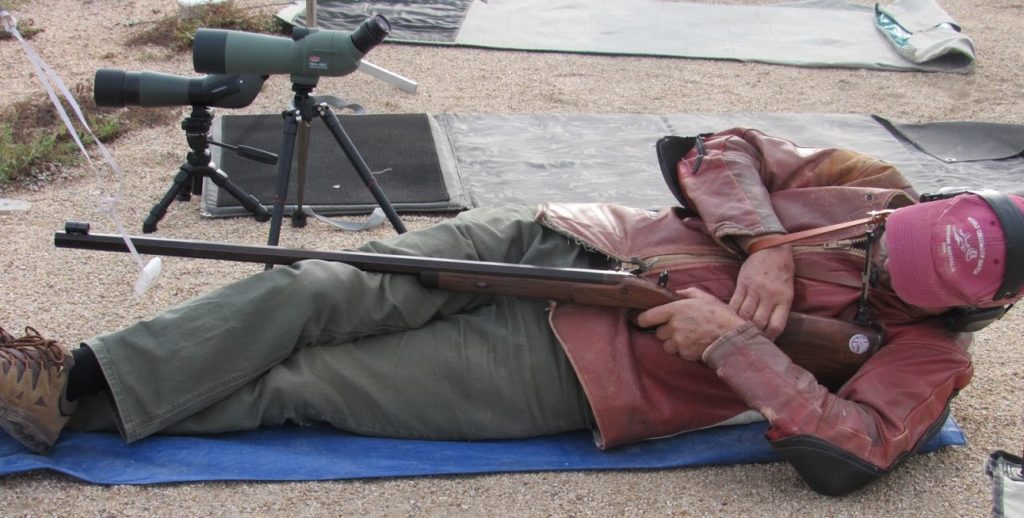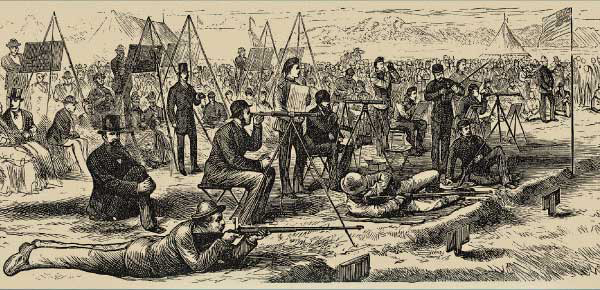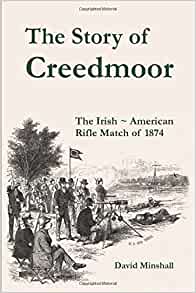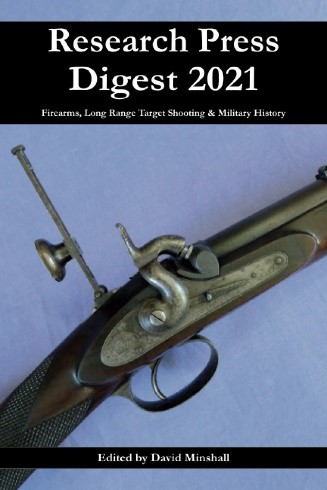The Creedmoor Match REBORN

The Creedmoor Match of 1874 is about to be reborn on its 150th anniversary in 2024. The original match between American and Irish teams shot on September 26, 1874 spurred the growth of organized shooting competitions in the U.S. and became a legend in the history of American shooting sports. 2024 will be the 150th anniversary.

The creation of anniversary Creedmoor Match is the brain child of Rick Weber, who is a fixture in black powder shooting. He serves on the Board of the National Muzzle Loading Rifle Association and a member of the Oak Ridge Sportsmen’s Association (ORSA), where he has organized long-range muzzle loader matches for the past 25 years.
The question people ask today about the original match is “How good are we compared to those shooters back in 1874?” Rick says, “Now we’ll have a chance to find out.” The match is tentatively planned for some time in October, 2024.
At the moment Rick is still mulling over the details in terms of targets, equipment, relay time length, etc. but this is his thinking to this point.
The planned week-long match might be shot in two segments. The first “Creedmoor Open” match would be at the beginning of the week and be like any other, using muzzle loaders and any type of cartridge gun currently used in regular competitions using rules appropriate to the type of gun. People will be able to use cross sticks or wrist rests as well as ground placed spotting scopes. “We’ll have practice shots and sighters the day before the anniversary Creedmoor Match segment. Wednesday, for example would be the practice day.” says Weber.
Only the types of guns used in the original Creedmoor will be used in our anniversary Creedmoor…side-lock muzzle loaders and 1874 Sharps and Remington Rolling Block rifles (no under hammers for example). The anniversary Creedmoor will be under rules that closely approximate the original Creedmoor. That is, no practice shots, no sighters, no coaching, perhaps no ground based scopes (Rick is still mulling much of this over). And, body support only! No cross sticks or wrist rests. The rules for the original match stated, “Any position can be assumed, but no artificial rest is permitted either for the rifle or person of the shooter.” Several of the newspaper illustrations of the time showed shooters in the recumbent position. Seldom seen today, it is the most stable of all positions. Below, Kiwi Laurie Kerr used it to great effect at the 2019 Long-Range World Competition in Australia. Note the strap running from Kerr’s wrist to the back of his head. It is allowable under current rules, but not those of in the original match.

Cartridge shooters will fire15 shots in 30 minutes, muzzle loaders 15 shots in one hour. Distances will be 800, 900 and 1,000 yards. “No spotters or coaching,” Rick says adding, “It makes a real difference when the spotter says, ½ minute left or right. This is all on the shooter.”

Weber has been in conversations with David Minshall of the Muzzle Loaders Association of Great Britain and notes interest of some of their shooters in crossing the pond to participate. (Wouldn’t that be a hoot!)
Origins of the Creedmoor Match: A Challenge from Ireland
What sparked the match was a letter sent to the New York Herald and published on November 22, 1873 entitled “Challenge to the Riflemen of America from the Riflemen of Ireland.” The challenge was posted in a newspaper because the Irish did not know the American NRA existed.
The American NRA, which was founded the year before, was reluctant to accept the challenge because of the lack of experienced, world-class long-range shooters. So, the Amateur Rifle Club (ARC) of New York City took up the challenge. The ARC was organized in 1872 by Colonel George W. Wingate who had been appointed on the staff of the Brooklyn Division of New York State Militia. However, as opposed to military training, the purpose of the ARC was to promote long-range rifle practice without regard to military organization and with other than military rifles. In essence, the ARC was a sporting club, with the challenge of long-range shooting as an amusement. This appealed to many and in a short time the club grew greatly by attracting shooters with no interest in soldiering or being in a regiment. Nevertheless, as it was, the first contest of the ARC for their gold badge was held in July, 1873, and then at only five-hundred yards! The Irish-American match was scheduled for September 26, 1874. The Americans had to hustle to develop expertise at long-range as they were at a serious experience disadvantage relative to the Irish.
Each team had six members. One of the conditions of the match was that each team had to use guns made in their respective countries. The U.S. shooters used cartridge guns such as the Sharps Model 1874 #3 rifle and the Remington Rolling Block; the Irish used Rigby muzzle loaders (Ireland was then a British colony). The distances were 800 hundred and 900 hundred yards to be shot in the morning and 1,000 yards after lunch.
The targets were different than those used today. They were twelve feet wide and six feet high and divided into three sections. The center section was a six-foot white square. At the very center of that section was a three-foot black square. The black square was the bullseye and hits on it had a value of four points. The white areas of the center section had a value of three points. To the left and right of the center section were side sections each three feet wide and six feet high. Hits on the side sections were worth two points. The same size targets were used for each of the three distances.
For those readers of this article who have no long-range experience, a three-foot square bullseye might sound very big. At 1,000 yards it looks much like a three-hundredths of an inch dot on a piece of paper held just 3 feet from your eye. That’s about the size of a period at the end of a sentence.
As noted above, there were NO sighters and body support only. None of the illustrations of the match printed in newspapers at the time showed the use of slings.
The Match; A Close–Run Thing
The 800 yard match went to the American Team 326 to the Irish 317. In that match Irish team members had a mere two misses. The Americans, none.
The 900 yard match was different. And it was in that match that a critical mistake that might well have cost the Irish the entire match. J. K. Milner, one of the better Irish shots, scored a four-point bullseye, but, on the wrong target and it was scored as a miss. (As we all know, there are two kinds of shooters; those who have cross-fired and those who are going to, and going to again.) In the end the Irish team scored 312, the Americans, 310. Still, the aggregate total for the Americans was 636 versus the Irish 629. A good lead and the Yanks were confident.
It was at the 1,000 yard line where it could have gone either way. One American team member General T. S. Dakin turned in a 41 of a possible 60 points, a poor performance. He had three misses out of his fifteen shots and it almost cost the U.S. team the match. However, Dakin’s poor performance was partially offset by a score of 57 by H. Fulton. As it was, the 1,000 yard match was won by the Irish with a score of 302 to the American’s 298.
However, the aggregate score with one shot remaining for the Americans, was 931 for the Irish and 930 for the Americans.
For the last shot of the match, John Bodine, a 44 year-old former Colonel in the New York Militia, thenceforth named “Old Reliable”, went into his prone position, took aim, and “sent it” scoring a 4-point bullseye giving the American team the aggregate score of 934 and victory.
Further Reading

Most of the information in this article came from The Story of Creedmoor, The Irish American Match of 1874 edited and annotated by David Minshall.The central story of Creedmoor is told via an extensively annotated article from 1876, the writer’s enthusiasm giving a feel for the times and in the lead up to the Centennial Match at Creedmoor that year. Minshall provides background information on events that led to the Irish challenge and the 1874 rifle match and concludes the story with details of the follow-up match at Dollymount, Ireland, in 1875. It is available from Amazon, and a great read.
Another book of interest is the Research Press Digest 2021, Firearms, Long Range Target Shooting & Military History. Available on Amazon, and full of articles of interest to the black powder shooter, the book provides a wealth of information on subjects varied as:

- Match and military rifles.
- The rise and demise of the match rifle.
- The challenges of hand loading ammunition.
- A history of progress of military firearms to 1866.
- An introduction to the Whitworth rifle and a history of the Rifle Musket, Pattern 1853.
- The British Military School of Musketry at Hythe.
- The Royal Small Arms Factory, Enfield
- The Small Arms of European Armies’ (1889) gives coverage of the subject from an American viewpoint, being written by a US Inspector of Ordnance, and more.
Many of the reprints are supplemented with annotation providing historical context to the original articles, plus images from the editor’s collection. Again, a great read.